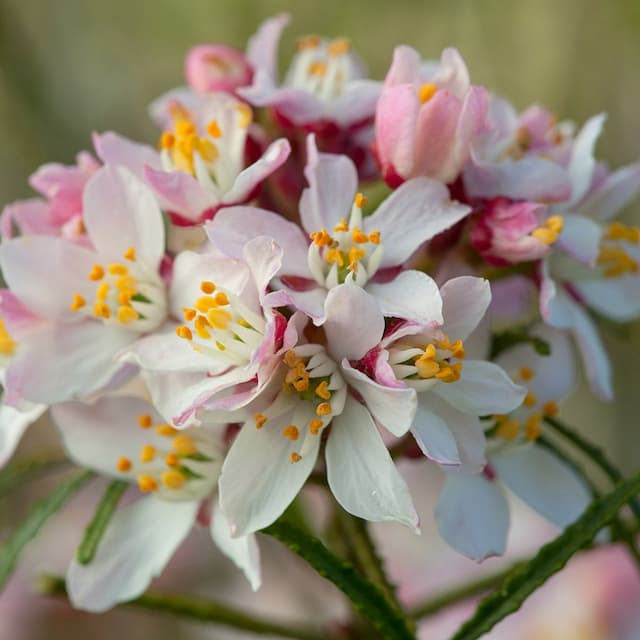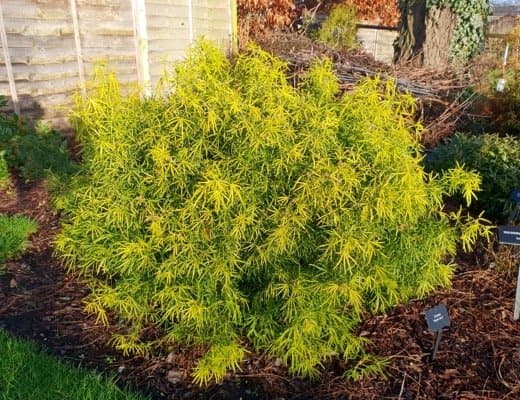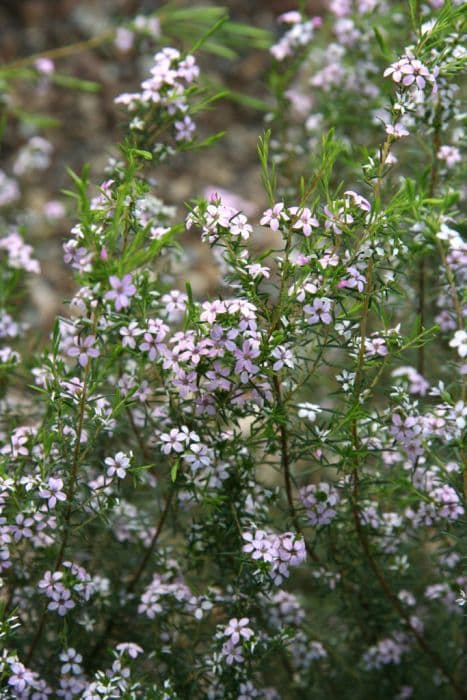Yuzu Citrus × junos

ABOUT
Citrus × junos, commonly known as yuzu, is a distinctive plant primarily known for its aromatic and flavorful fruit. The yuzu plant bears thorny branches and has a rugged appearance. The leaves are dark green, glossy, and oval to lance-shaped with a pointed tip. They possess a characteristic citrus look, similar to other plants in the citrus family, with the petioles (leaf stalks) often slightly winged. The yuzu produces fragrant, white flowers that usually have five petals. These blossoms emit a pleasant, citrusy aroma that can attract bees for pollination. Following the flowering stage, the plant bears fruit that is typically round or slightly elongated with a rough and uneven skin. The rind of the yuzu fruit is usually thick, and the color matures from green to a vibrant yellow or sometimes a slightly orange hue as the fruit ripens. The interior of the yuzu fruit contains numerous seeds within the juicy, segmented flesh. The flesh has a tart and acidic flavor, reminiscent of a cross between a grapefruit and a mandarin with hints of lime. The yuzu's acid level can vary, but it's recognized for its distinct taste that is highly sought after in culinary applications. The aroma of the fruit is especially notable, possessing a zesty, fresher scent compared to other citrus fruits, which makes it a popular ingredient for flavoring and aromatic purposes.
About this plant
 Names
NamesFamily
Rutaceae
Synonyms
Yuzu, Japanese Citron, Yuja
Common names
Citrus ichangensis × C. reticulata var. austera, Citrus junos, Citrus cavaleriei × Citrus reticulata.
 Toxicity
ToxicityTo humans
Yuzu is not considered toxic to humans. As a citrus fruit, it is commonly used in cooking and food preparation. There are no well-known toxicological symptoms associated with ingesting yuzu fruit, peel, or juice in normal food quantities. However, citrus plants can cause mild stomach upset if eaten in excessive amounts, due to their high acid content. Additionally, the essential oils present in the skin can be irritating to the skin and mucous membranes if handled excessively without protection.
To pets
Yuzu is generally not toxic to pets. As with most citrus plants, the essential oils and psoralens found in yuzu could potentially cause irritation or upset stomach if consumed by pets in significant quantities, but this is not common. Symptoms of any reaction would likely include gastrointestinal upset such as vomiting or diarrhea. It is always best to keep an eye on your pets and prevent them from consuming plants not specifically intended for them.
 Characteristics
CharacteristicsLife cycle
Perennials
Foliage type
Evergreen
Color of leaves
Green
Flower color
White
Height
6-30 feet (1.8-9 meters)
Spread
6-15 feet (1.8-4.5 meters)
Plant type
Shrub
Hardiness zones
8
Native area
East Asia
Benefits
 General Benefits
General Benefits- Culinary Uses: Citrus × junos, commonly known as yuzu, is valued for its unique tart flavor and aromatic zest, which is used in cooking and baking to enhance dishes and desserts.
- Rich in Vitamin C: Yuzu fruit is known for its high vitamin C content, which is essential for immune system support and skin health.
- Flavoring Agent: The juice and peel of yuzu are often used to flavor beverages, marmalades, and sauces, imparting a distinctive citrus taste.
- Aromatherapy: Yuzu's fragrant aroma is appreciated in aromatherapy for its ability to help reduce stress and promote relaxation when used in essential oils and scents.
- Natural Preservative: Yuzu's citric acid content serves as a natural preservative in foods, helping to extend shelf life while adding flavor.
- Aesthetic Value: The yuzu tree, with its glossy green leaves and bright fruit, is often grown for ornamental purposes, adding beauty to gardens and landscapes.
- Cultural Significance: In some cultures, yuzu is used in traditional ceremonies and festivals, holding cultural and symbolic meanings.
 Medical Properties
Medical Properties- Antioxidant: Yuzu is known to contain high levels of vitamin C and flavonoids, which can act as antioxidants and may help to reduce oxidative stress in the body.
- Anti-inflammatory: Some studies suggest that yuzu may have anti-inflammatory effects, which can be beneficial in reducing inflammation-related symptoms in various conditions.
- Antimicrobial: Yuzu extracts have demonstrated antimicrobial activity against certain pathogens, potentially supporting the immune system.
- Alleviating common cold symptoms: Due to its vitamin C content, yuzu might help in reducing the severity and duration of cold symptoms.
- Stress reduction: The aromatic scent of yuzu has been traditionally used for relaxation and to reduce stress, although clinical evidence supporting this is limited.
- Improved circulatory health: Flavonoids found in yuzu may contribute to improved cardiovascular health by promoting better blood circulation.
 Air-purifying Qualities
Air-purifying QualitiesThis plant is not specifically known for air purifying qualities.
 Other Uses
Other Uses- Culinary Garnish: Yuzu's aromatic rind can be finely grated or sliced to add a burst of citrus scent and flavor to desserts, cocktails, and savory dishes.
- Bath Additive: In Japan, yuzu is traditionally added to hot baths during the winter solstice, a practice said to ward off colds and rejuvenate the skin.
- Perfumery: Yuzu oil is used in perfumery for its fresh and uplifting scent which can act as a top or middle note in fragrance compositions.
- Flavoring for Vinegar: Yuzu juice can be combined with vinegar to create a uniquely fragrant and tangy condiment, often used in salad dressings or as a marinade.
- Yuzu Honey Tea: The fruit can be mixed with honey to make yuzu tea, which serves as a warm, soothing beverage, especially during cold seasons.
- Infusion in Alcoholic Beverages: Yuzu's zest and juice are often infused in spirits like vodka or shochu, creating a citrus-flavored liquor.
- Yuzu Marmalade: The fruit's zest and juice can be cooked into a marmalade, providing a sweet and citrusy spread for toasts and pastries.
- Seasoning Paste: Yuzu kosho is a spicy Japanese condiment made from yuzu zest, chili peppers, and salt, used to flavor soups, noodles, and meats.
- Dyeing Fabric: The peels of yuzu contain natural dyes that can be used to color fabrics in shades of yellow, when processed properly.
- Crafting Material: Dried yuzu peels can be crafted into aromatic sachets, ornaments, or other decorative items, giving a pleasant scent to drawers and closets.
Interesting Facts
 Feng Shui
Feng ShuiThe Yuzu is not used in Feng Shui practice.
 Zodiac Sign Compitability
Zodiac Sign CompitabilityThe Yuzu is not used in astrology practice.
 Plant Symbolism
Plant Symbolism- Longevity and Good Health: In various cultures, the Citrus × junos, commonly known as yuzu, symbolizes longevity and good health due to its hardy nature and the high vitamin C content found in the fruit.
- New Opportunities and Good Luck: Yuzu is often associated with good luck and new opportunities, especially in regions where it is used in traditional ceremonies or as a New Year's auspicious fruit.
- Prosperity: As a vibrant and productive plant, the yuzu tree is sometimes seen as a symbol of prosperity and abundance, linked to the plentiful harvest it can provide.
- Cleansing and Purification: Due to its refreshing scent and properties, yuzu is often linked to purification rituals, suggesting a symbolic meaning of cleansing and renewal.
- Beauty and Care: In some cultures, the yuzu is a symbol of beauty and self-care, as its extracts are used in skincare and beauty products, thereby representing nurturing and pampering.
 Water
WaterThe Yuzu tree should be watered regularly, aiming to keep the soil moist but not waterlogged. During the growing season, water approximately every seven to ten days, providing around 1 to 2 gallons depending on the size of the tree and the weather conditions. Always check the top inch of soil for dryness before watering. Reduce watering in the winter when the tree is less active, possibly to every two to three weeks or as needed to prevent the soil from drying out completely. Make sure the plant has proper drainage to avoid root rot.
 Light
LightYuzu trees thrive in full sunlight, needing at least 6 to 8 hours of direct light daily. Place the tree in a location where it receives unfiltered, bright sunlight for the majority of the day. East or south-facing spots are ideal for maximum light exposure, but ensure that the plant is protected from intense afternoon sun in particularly hot climates.
 Temperature
TemperatureYuzu trees prefer a temperature range between 55°F and 85°F, with the ideal growing conditions around 65°F to 75°F. They can tolerate minimum temperatures down to about 20°F, but frost can damage the foliage and fruits. It's important to protect the tree from extreme cold and wind, so in areas with harsh winters, container-grown yuzu should be moved indoors or to a sheltered location.
 Pruning
PruningPrune Yuzu trees to remove dead or diseased wood, maintain shape, and encourage better air circulation within the canopy. The best time for pruning is in late winter or early spring before new growth begins. Pruning can be done annually, focusing on thinning out overcrowded branches and cutting back any growth that doesn't contribute to the desired structure of the tree.
 Cleaning
CleaningAs needed
 Soil
SoilYuzu trees flourish in well-draining, sandy loam with a pH between 5.5 and 6.5. An ideal soil mix includes equal parts of sand, peat, and perlite or pine bark to provide the necessary drainage and aeration.
 Repotting
RepottingYuzu should be repotted every 2-3 years, preferably in spring or early summer before new growth begins, to prevent root-bound conditions and renew nutrient availability.
 Humidity & Misting
Humidity & MistingYuzu trees do well with moderate to high humidity levels, around 50-60%, which help replicate their native subtropical habitat conditions.
 Suitable locations
Suitable locationsIndoor
Place yuzu near a sunny window, ensure good air circulation.
Outdoor
Plant in full sun, shelter from strong winds, protect during hard frosts.
Hardiness zone
8-11 USDA
 Life cycle
Life cycleThe Yuzu, or Citrus × junos, begins its life cycle with seed germination, where they sprout and form a small seedling. The growth phase follows, where the seedling establishes root systems and foliage through photosynthesis and nutrient uptake. As it matures, the Yuzu develops into a flowering plant, producing fragrant white blossoms that attract pollinators, a critical step for fruit set. Once pollinated, the flowers develop into the characteristic Yuzu fruit, which resembles small, bumpy citrus fruits that ripen to a yellow or greenish color. After reaching maturity, the fruit is harvested, and the seeds can be dispersed to produce new plants, completing the cycle. The Yuzu’s life cycle can also be perpetuated vegetatively through grafting, which is often preferred for maintaining specific cultivar traits.
 Propogation
PropogationPropogation time
Spring-Early Summer
The Citrus × junos, commonly known as Yuzu, is generally propagated through grafting, the most popular method for this plant. Grafting involves joining a piece of vegetative wood, the scion, from a desirable Yuzu tree with a rootstock that provides vigor and disease resistance. This is typically done in late winter or early spring before the bud break when the plant is still dormant. The budwood, which is a year-old growth that has matured, is cut into lengths of 4 to 6 inches (approximately 10 to 15 centimeters) containing several buds. The cuttings are then grafted onto rootstock through methods such as bud grafting or cleft grafting, and the graft union is sealed with grafting tape and wax to prevent desiccation. After grafting, it is crucial to maintain a high humidity environment for the scion to successfully unite and grow with the rootstock.









